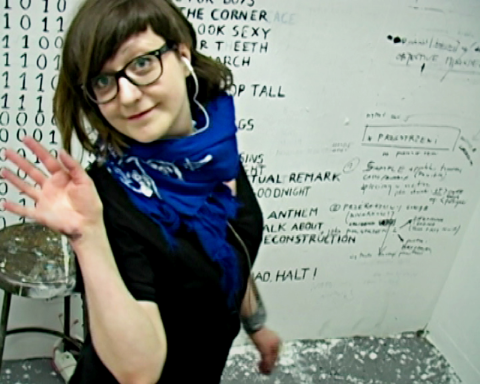Julia Kul is a young emerging artist known for critical yet playful work that interrogates the prescribed nature of gender roles and national identities. Kul was born in Gdansk, Poland, in 1983. After studying graphic design at the Academy of Fine Arts in Gdansk, she earned her MFA in intermedia at the same institution in 2010. Kul has received several awards in recognition of her incisive artwork, including the Erasmus Scholarship, which enabled her to study at Sabanci University in Istanbul, Turkey, and a Fulbright Grant, which funded her move to New York City, her current place of residence. Over the past two years, she has studied in the fine arts program at Parsons The New School for Design and exhibited at venues in Poland and New York, including Judson Memorial Church, Flux Factory, and Postmasters Gallery.
Much of Kul’s work revolves around modes of instruction, which she both critiques and utilizes to generate performances. In doing so, she figures social roles and behavior as learned, not natural. In her video performance _Worth Waiting For_ (2012), Kul lip-syncs the dialogue from a 1962 Mormon film and cautionary tale about the sanctity and responsibility of marriage. She plays most of the characters, including Julie and Joe, two high school students who have decided to marry to the dismay of the football coach and their teammates, family, and friends. Joe quits the football team so he can get a job and Julie lashes out at her parents. However, after observing the difficulties of motherhood, Julie returns her ring to Joe and asks him to wait for her until they graduate. Kul’s skillful, amusing mime of 1960s moral instruction set against a plain, white background attunes the viewer to the contrivances of the plot and dialogue, encouraging him or her to approach the film as less educational and more performative.
Likewise, in _Let’s Make a Sandwich_ (c. 2012), Kul appropriates a short instructional film on sandwich preparation from 1950. She slows down the voice of the narrator to present a mother and daughter making tuna rarebit in silence. Rather than presenting the directions of the recipe on screen, Kul inserts text that lists her own instructions for “How to be a girl in the USA.” Such lines as “Unfold your romantic delusions and squeeze your waist” and “Ask for mercy (and painkillers)” imply that the mother in the film is not only teaching her daughter how to make a sandwich, she is also effectively training her to perform her gender through the service of others.
Kul also links food to the performance of identity in _Artist as a Restaurant_ (2012), a large-scale drawing centered on a traditional Polish menu. Each item on the menu is linked to a set of directions for a performance based on an aspect of Polish culture and history. One dish entails the performance of “a long (60-person) queue…typical for +the communist model of consumerism+.” For another item, “the artist will spit into your plate for +5 minutes+ …[to] give you the sense of Polish/Christian disdain for other human beings.”
In _Passport Reading_ (2011), Kul directs her performance in a similarly arbitrary, unfixed manner, thus further underscoring the instability and fallibility of gender roles and nationalist values. The video opens with a list of thirty-five commands, each of which corresponds to a letter (A to Z) or number (0 to 9). The natures of the directives range from simple and straightforward (go, stop, left, or right) to difficult or complex (shut up, be nice for boys, try to look sexy, or make an intellectual remark) to irrational or impossible (be happy in USA, repent of your sins, get down, Germans! or fuck you!). Kul then performs these commands as their corresponding letter or number appears in the text of her passport. These include her passport number, surname, given name, date of birth and personal identification number as well as the document’s date of issue and authority.
As the reading progresses, Kul becomes increasingly disoriented in her struggle to keep up and comply with each command. While her persona is charming and good-humored, Kul’s act nonetheless points to tensions between the self, the construction of social identity and the regulation of national identity. Thus, she calls upon the viewer to question who or what the passport identifies. Does it provide the identification of an individual or the invocation of others’ expectations and stereotypes? _—Kanitra Fletcher_

